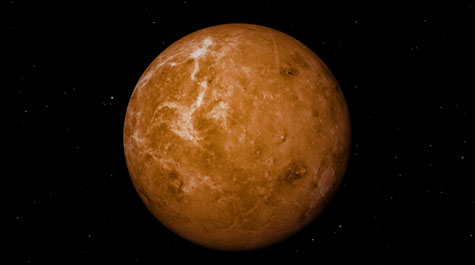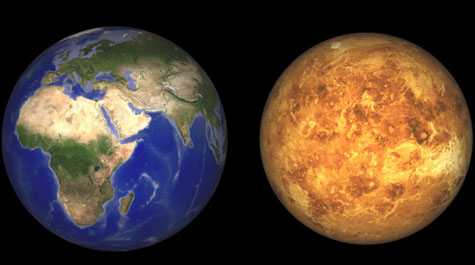Taking a drive to Venus? W&M physicist does the math
In November of 2005, the satellite Venus Express at a speed of about 18,000 miles per hour made the trip to the second planet from the sun in about 155 days.
In the spirit of learning more about the complexities of space exploration, W&M News recently sat down with Eugeniy E. Mikhailov, an assistant professor of physics, to pose a question. Just how long it would take to drive a car — not a vehicle capable of achieving speeds of nearly 20,000 miles per hour like the Express — to travel to Venus?
Mikhailov, whose research focuses on quantum enhanced measurements stated that if everything went according to plan, that is, if the weight of the vehicle including passengers, fuel-consumption and the distance to Venus was just right, a car could make it to one of Earth’s closest stellar neighbors in about half a century.
“First, you’re going to need a rocket with enough fuel that can produce enough force to lift you and your payload of passengers and equipment needed for the trip off Earth’s surface,” he said. “In addition, fuel needed for the rest of the journey to control and perpetuate motion through space is very important. Oxygen, food and water must be available too. So, you’re going to have to pack your belongings properly.”
{{youtube:medium|0IIDwGui6Uc, Eugeniy E. Mikhailov, an assistant professor of physics at William & Mary discusses the difficulties that would be expected if humans were to ever travel to the planet of Venus}}
According to the Jet Propulsion Laboratory at California Institute of Technology, it takes about three days to travel the nearly 240,000 miles to get to the moon from Earth using the optimal speeds of space-craft like Apollo 11. However, the specific distance can change depending on the trajectory taken, the JPL says.
But if you wish to move past that distance and head to Venus, plan on bringing a few books because Venus is about 100 times farther than the distance from the moon is to the Earth. And depending on the actual date, the distance between Earth and Venus increases, so you will have to time your trip to well in advance, according to Mikhailov.
“If you were to use the face of a clock as an example to denote our placement in the solar system it would look something like this,” he said. “The Earth will signify the hour-hand, Venus will represent the minute-hand and the center of the clock is our sun. And just like a clock, there will be a point when those hands have moved apart so much that they are totally opposite of each other. Every couple of years or so, this same pattern applies to Earth and Venus. Venus’ distance from Earth increases as the years on our planet passes. This will happen to the point that Venus’ orbit will place it on the opposite side of the Sun while our planet’s position remains on the side. Therefore, at its furthest, Venus’ distance can be about 160,000,000 miles away or about 1.7 astronomical units so you’re going to have to time your departure from Earth before our two planets come within their closest distance.”
The speed of the vessel traveling to Venus is also extremely critical to a successful voyage, Mikhailov said. An automobile moving through space while maintaining a speed of 60 miles per hour to help conserve fuel would take about 50 years, said Mikhailov.
{{youtube:medium|9YiNz0crP2o, Eugeniy E. Mikhailov, an assistant professor of physics at William & Mary calculates the time and distance it would take to travel to the planet of Venus.}}
“Believe it or not, that’s kind of a reasonable estimate,” he said. “However, I wouldn’t wish anyone to be stuck in a car with anyone else for that long of a time. You and your best friend may not be best friends after that trip.”
According to Mikhailov, once on Venus, the travelers would have to consider the inhospitableness of the planet’s atmosphere. The planet’s temperature is a serious concern to human life and the equipment used to facilitate a working environment would be destroyed by the intense heat. Therefore, Mars—with its extremely cold temperatures—would probably be a better choice for humans to colonize even though it is farther away than Venus, said Mikhailov.
“Just think about how hot your oven gets when you’re baking cookies at an average temperature of about 400 degrees Fahrenheit,” he said. “Well, double that number on the planet of Venus. The planet’s overall [surface] pressure is dangerous to human physiology as well. Our computers which we will need to operate on Venus are designed to operate within the Earth’s normal temperature. Maybe a little below the point of freezing and maybe up to the point of boiling water. So, our equipment would be damaged or destroyed almost immediately and that will make living there very difficult.”
However, there are a few things a human would appreciate living on the surface of Venus, Mikhailov said.
“We would feel slightly lighter [in weight],” he said. “The gravitational pull on that planet’s surface is about 90 percent that of Earth’s. So, that means we could possibly jump a little higher and walk a little easier.”
{{youtube:medium|SGpNFQWyC6k, Eugeniy E. Mikhailov, an assistant professor of physics at William & Mary discusses the logistical aspects of space flight to the planet Venus.}}
Currently, Mikhailov is working on several quantum optics projects. In particular he is researching the imaging of the squeezed (below standard quantum limit) quantum states. He and his team hope to have preliminary results within the coming year.

















